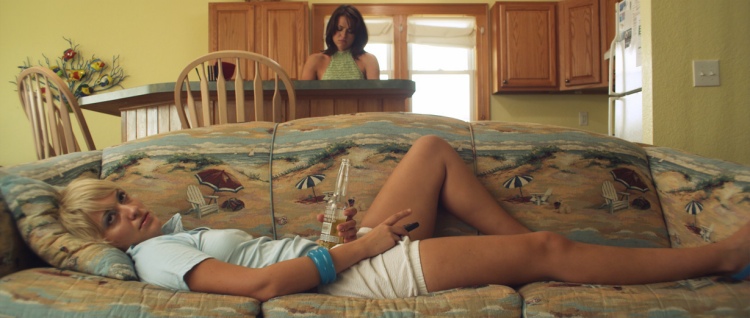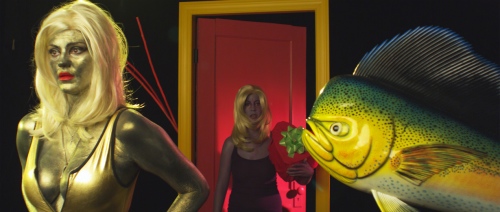
Vacation! starts with a black and white, split-screen sequence in which Sugar, Lorelei, Donna and Dee-dee arrange, through a series of phone calls, to spend an impromptu week away together at a beach house. Cut to the opening credits, all loud music, vibrant colours, old fashioned fonts and handheld handycam footage. The tone boarders on the surreal, a sense of playful postmodernism dominating the proceedings (there’s a whiff of Tarantino in the air). Some text flits by on the screen – something about a death, a hint of darkness – but the mood is too playfull, too excited (and exciting) for us to really care.
Unfortunately the pace comes to a swift halt after this excellent opening. The girls have arrived at the beach house, and things get pretty dull pretty quickly as the girls lounge around, enjoying their vacation more than we do. There’s a focus in these early scenes on temps mort, but one that perhaps never becomes as interesting or as entertaining as it should. The film’s director, Zach Clark, was editor on Aaron Katz’s Dance Party, USA, and it’s interesting to note Vacation!’s links to that film and the so-called ‘Mumblecore’ movement which surrounds it. Here, as there, the film is driven by pitch-perfect natural performances. Yet Vacation! is something more than another twentysomething drama. The film begins to pick up momentum again as the relationships between, and the personalities of, the four girls slowly start to reveal themselves. The range of personalities within the quartet works perfectly, with Clark offering us four distinct individuals without it ever seeming forced or tokenistic. It’s a genuinely interesting mix, and it’s refreshing to see the lives of four strong female characters, and their sexuality, explored so well.
 Perhaps as can be expected for a film that starts so vibrantly, things being to take a turn for the worse as the film progresses. A game of hide and seek becomes tense thanks to some cunning filmmaking and the spectre of the girls’ earlier encounter with the seedy character of The Surfer. As if moving from dream to nightmare, things get even darker during a long, bizarre neon-coated acid trip. The film’s compassionate stance towards its characters (even towards The Surfer, who begins as the film’s comic foil) is refreshing, but it can’t hide the ultimately dubious morality of their actions (further shades of Dance Party, USA, perhaps?). By the time the film concludes it’s hard not to feel conflicted about these characters, their decisions and their motivations. But, as the film rightly shows us, modern life and old friendships are never easy.
Perhaps as can be expected for a film that starts so vibrantly, things being to take a turn for the worse as the film progresses. A game of hide and seek becomes tense thanks to some cunning filmmaking and the spectre of the girls’ earlier encounter with the seedy character of The Surfer. As if moving from dream to nightmare, things get even darker during a long, bizarre neon-coated acid trip. The film’s compassionate stance towards its characters (even towards The Surfer, who begins as the film’s comic foil) is refreshing, but it can’t hide the ultimately dubious morality of their actions (further shades of Dance Party, USA, perhaps?). By the time the film concludes it’s hard not to feel conflicted about these characters, their decisions and their motivations. But, as the film rightly shows us, modern life and old friendships are never easy.

